In the early morning of 12 September 1683, in the ruins of the church of St Joseph on Kahlenberg Hill near Vienna burnt by the Turks, Mark of Aviano, an Italian Capuchin sometimes referred to as the ‘spiritual father of Europe’, celebrated Mass for the success of the battle against the Ottoman Empire. The King of Poland at the time, John III Sobieski, served at that Mass.
by Piotr Bejrowski
The Ottoman Empire grows in strength
The policy of the Ottoman Empire was based on aggressive expansion. The Ottoman Sultanate had been invading more countries since its establishment, conquering Byzantium, Bulgaria and Serbia, among others. The fall of Constantinople in 1453 and the transformation of the famous city into the capital of the Ottoman Empire, henceforth known as Istanbul, caused dismay in European courts, but the sultanate did not stop there. Southern Italy was also threatened when Rome was targeted by the Ottomans – only the death of the brave Mehmed II in 1481 thwarted these plans.
The Sultan’s state reached the height of its power under Suleiman the Magnificent in the following century, when its borders stretched around the eastern Mediterranean. The monarch himself even managed to reach Vienna in 1529, but eventually backed down after a siege of several weeks.
Suleiman was not discouraged by the setback and continued his conquests in Asia and Europe. Waging wars against the powerful Habsburgs, he managed to force them to pay tribute, as well as renouncing (in the Turkish version of the treaty) the title of emperor, which symbolically confirmed the sultanate’s claim to universal sovereignty over Europe. Hope was poured into the hearts of Europeans by the great triumph of the Holy League fleet over the Ottoman Empire during one of the bloodiest naval battles at Lepanto (1571).
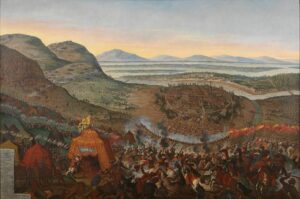
The Commonwealth on fire
The entire 17th century was one of devastating wars, and Poland, standing at the height of its power, had to face Russia, the Swedish invasion, as well as internal rebellions, the most severe of which was the Cossack uprising led by Bohdan Khmelnytskyi.
With the Polish-Lithuanian Commonwealth embroiled in devastating wars and Europe mired in the conflict later to be known as the Thirty Years’ War, the sultanate saw this as an opportunity to take control of some of its neighbour’s vast territories. The Polish army managed to repel the Turkish invasion, but failed to defeat the enemy. Crucial at the time was the 1621 Battle of Chocim (now Khotyn), when an army led by Hetman Jan Karol Chodkiewicz repulsed an attack by the forces of Sultan Osman II despite being two or three times smaller.
At the time, the Ottoman Empire was in crisis due to the rising costs of waging successive wars, crop failures and internal struggles between factions. The Köprülü dynasty emerged victorious from the latter in the middle of the 17th century and set about energetically putting the state in order. As a result, the Ottomans were able to return more forcefully to an expansive policy on the continent in the following years. They managed to seize Kandia, the most important Venetian fortress on Crete, and in 1672 captured the powerful Polish fortress at Kamieniec Podolski (now Kamianets-Podilskyi). Further Turkish advances were halted at Chocim a year later by the army of the future Polish king, Hetman Jan Sobieski. Showing their admiration for his skill, the Turks themselves henceforth began to call him the ‘Lion of Lechia’.
In 1669, Michał Korybut Wiśniowiecki became King of Poland; unfortunately, the only thing he inherited from his father, an outstanding commander, was his surname. Thoroughly educated and fluent in eight languages, he did not wish to be a monarch. His candidacy was the result of political turmoil and did not bring consent or authority to the indecisive ruler. Shortly thereafter, following a reign of only four years, Wiśniowiecki died at the age of 33, and the nobility chose as king the man who was a suitable wartime leader – John III Sobieski.
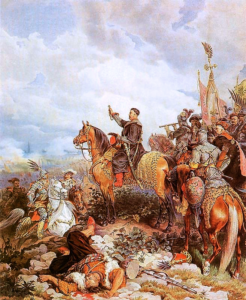
On to Vienna!
The war between Poland and the Ottoman Empire ended with the signing of a truce in 1676. The Poles still perceived the Turkish threat and put forward a proposal to form an anti-Ottoman alliance, but Emperor Leopold I was not interested and preferred to engage in conflict with France. It was only after some time, in the face of an imminent threat to his empire, that building a coalition began. Enjoying the relative support of Louis XIV and with the anti-Habsburg Hungarian insurgents on their side, the Turks began forming an army in Adrianople in early 1683. It is estimated that up to 300,000 men stood at the walls of Vienna – the largest army the Ottoman Empire had mobilised in the 17th century.
In July 1683, the huge army of the vizier Kara Mustafa reached Vienna. It soon surrounded the city and initiated a siege. For several weeks, the imperial capital, well-fortified and equipped, defended itself bravely, successfully repelling enemy attacks. Emperor Leopold I and Pope Innocent XI sent dramatic appeals to Poland for help and the defence of Christianity. Vienna’s future was beginning to look dramatic. John III Sobieski showed impressive acumen in forming his army. In a remarkably short time, he managed to assemble more than 20,000 soldiers. And this despite Poland’s complicated legal system for waging war (among other things, permission to fight outside the country’s borders had to be granted by the Sejm, as did the passing of an emergency tax for the campaign). In addition, the king himself allocated almost half a million zlotys of private funds for the war. The Poles reached the Danaube in just three weeks.
This was possible thanks to the extremely fast pace of covering the route – several dozen kilometres a day. During a war council held in Stetteldorf on 3 September, Sobieski was handed a marshal’s mace. The Polish king then took command of the combined Austrian, German and Polish forces, which together numbered some 70,000 men. Poles made up a third of them. There was no consensus among the allies as to the form in which the attack should be carried out. The Austrians and Germans wanted above all to cut the Turkish communication routes, thus forcing the besiegers to retreat. The Polish king, however, was confident in his troops and ordered a proper battle to be fought.
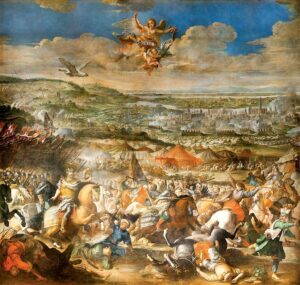
The battle that saved Europe
On 11 September, the Poles reached Kahlenberg Hill, which the Austrians had captured several hours earlier. Only then was Sobieski able to examine the terrain of the future battle. At that time, he noticed that it differed significantly from that shown on maps and in descriptions sent by the imperial commanders.
In the early morning of 12 September, the imperial forces began preparations for the confrontation. The left wing commanded by Prince Charles of Lorraine struck at Ibrahim Pasha’s positions and successfully limited the possibilities available to the enemy forces. Charles halted his advance to give the remaining troops some time to reinstate order at the front. At the same time, the Poles captured Schafberg Hill and began a slow forward march. Kara Mustafa decided to reinforce the attacked wing, and the Poles took up starting positions for the crucial charge on the Ottomans. The attack of two Polish regiments broke through the first line of defence inflicting heavy losses on the Turkish troops, but they also suffered these themselves, and became stuck on subsequent fortifications. In the circumstances, Kara Mustafa decided to reinforce the left wing, even withdrawing some of the troops fighting against Charles. In the afternoon, Sobieski made the decision to carry out a powerful charge using his famous hussars with the support of the Austrian and German cavalry.
However, he initially planned to make the decisive strike only on the second day of the battle. He changed his plans when he saw the enthusiasm among the allies and simultaneously the bad mood among the Turks. At the same time, he feared the withdrawal of the Turkish army to more favourable positions. After a brief consultation with Prince Charles and Prince Georg Friedrich von Waldeck, who commanded the cavalry group in the centre (the same one who commanded the cavalry against Poland during the Battle of Warsaw in 1656), he gave the order to attack.
Around 6 p.m., the roar of cannons and muskets rang out, giving rise to confusion in the Turkish ranks. ‘Let my hussars break those ranks!’ Sobieski bellowed. The 20,000-strong cavalry commanded by the Polish monarch pressed from the right wing against the enemy line. The defenders could not withstand the momentum of the assault. Subsequent units fell into disarray. The Janissary infantry, which had hitherto besieged Vienna, also became disorganised. The terrified Ottomans fled in panic. Kara Mustafa and his entourage also fled the battlefield. Sobieski’s decisive charge lasted half an hour. This was enough to liberate Vienna. The majority of the Turkish troops managed to escape, saving their lives in the process. However, they lost much of their armament and all their guns. The victory was complete.
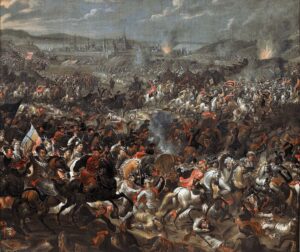
Venimus, vidimus, Deus vicit
After the battle, John III Sobieski wrote two letters. One to his wife and the other to Pope Innocent XI, in which he included significant words that are a paraphrase of a quote by Julius Caesar from the time of the Battle of Zela: Venimus, vidimus, Deus vicit. To the letter he attached a banner hung over Kara Mustafa’s tent. He sent his wife Kara Mustafa’s stirrup, which was given to Wawel Cathedral as a votive offering, and placed by Queen Maria Kazimiera in front of the altar there. As stirrups were considered one of the most important battle trophies back then, that trophy was a symbol of a major accomplishment.
The Viennese welcomed the Polish monarch like a true hero. However, Emperor Leopold received him coolly and with manifest superiority. Sobieski expressed his grief in a letter to his beloved wife in the words: ‘We stand here, on the banks of the Danube, like the people of Israel once stood by the Babylonian waters, weeping over our horses, over an unheard-of ingratitude’.
As late as the 20th century, Austrian and German historiography attempted to diminish the merits of the Polish allies by understating the number of forces mobilised, unfoundedly criticising the discipline of the Polish-Lithuanian Commonwealth’s troops – it was even written that they oppressed the local population almost as much as the Turkish army…. And the Emperor was said to have agreed to hand over the mace to Sobieski solely because of his stubborn refusal to obey imperial orders. However, it was thanks to the Poles that the enemy was defeated. This does not mean, however, that they would have been able to smash Kara Mustafa’s army on their own – the role of the Austrians and Germans in the battle did matter a lot, and it was only thanks to the cooperation of the allies and the consistent implementation of the battle plan proposed by the Polish command that the final triumph was made possible.
Several days after the clash, Charles Lorraine himself admitted that ‘the King of Poland gained immortal fame in this clash, since for such a great undertaking he came from his kingdom and acted like a great king and a great leader. I, on the other hand, acted only by giving instructions, which were accepted and followed.’
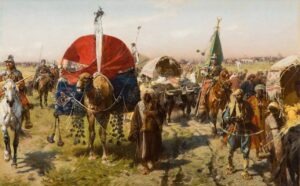
The Battle of Vienna marked the beginning of a long Polish-Turkish war that lasted 16 years of that century. On 7 October, near the heavily fortified port of Párkány (now Štúrovo), the returning Polish army and imperial troops were unexpectedly attacked by the Ottomans under Kara Mehmed Pasha, who had taken over from Kara Mustafa. Sobieski himself narrowly missed being killed. It was not until the following day that the Polish ruler concentrated his forces and fought the Turks in battle. That time around the opposing forces were almost completely crushed.
The catastrophe of the Grand Vizier’s army definitely thwarted the prospect of conquering Central and Eastern Europe. After fleeing the outskirts of Vienna, Kara Mustafa retreated to Belgrade. There, on the orders of Sultan Mehmed IV, he was strangled to death with a bowstring on 25 December 1683.
The Battle of Vienna saved Europe. However, it was the last such great military success for the Polish-Lithuanian Commonwealth, which, plagued by numerous difficulties, was in decline. One hundred years later, Russia, Prussia and Austria, which owed so much to Poland, partitioned the country.
Today, the chapel on Kahlenberg is a well-kept temple full of Polish memorabilia and decorations depicting the victory over the Ottomans, and the altar bears the memorable words of the Polish king: Venimus, vidimus, Deus vicit. However, no monument to John III Sobieski, commemorating his services to the city, has yet been erected in Vienna.
Author: Piotr Bejrowski
Translation: Mikołaj Sekrecki





